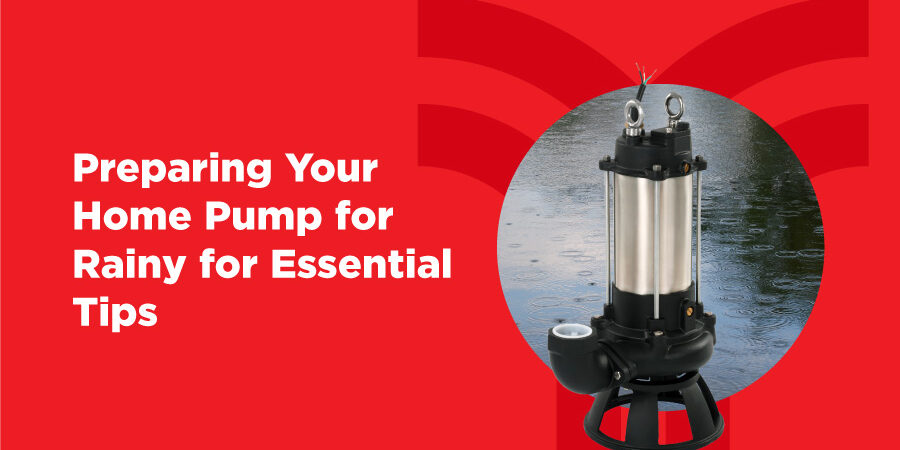Preparing Your Home Pump for Rainy Season – Essential Tips
As the rainy season approaches, it is important to ensure that your home is ready to withstand increased moisture and potential floods. Your home pump is an essential part of this readiness since it controls excess water around your property, preventing water damage. It’s possible to avoid expensive repairs and flood damage by taking the time to prepare your well pump or water pressure booster for the rainy season. These are some crucial pointers from the best Pump Manufacturers in Coimbatore to assist you prepare your home pump for the upcoming wet months.
Examine and Clean Your Pump
- A comprehensive check is the first step in getting your home pump ready for the wet season.
- First, look for any obvious wear and tear indicators on the pump including rust or corrosion.
- Electrical problems could arise from fraying or damage to the power cords, so pay close attention to them.
- Clean the pump after examination to get rid of any dirt that may have accumulated over time. This is particularly crucial for sump pumps since dirt can clog the entrance, decreasing the pump’s effectiveness or possibly leading to its complete failure.
Test the Pump’s Functionality
Check the Functionality of the Pump
- It’s time to test your pump’s operation after it has been cleaned.
- This can be accomplished with sump pumps by filling the sump pit with water and watching to see if the pump starts up and successfully removes the water.
- You may test other types of pumps by turning on the water and monitoring the flow and pressure.
- Verify that the pump is operating smoothly and that there are no odd sounds or startup delays.
- It’s better to take care of any problems you see right away rather than waiting until the rainy season is fully underway.
Check the Discharge Pipe and Ventilation
- The discharge pipe which removes water from your house is a crucial component of your home pump system.
- Check the discharge pipe during your preparation to make sure it’s free of waste.
- Water can back up and flood your basement or other areas of your house if a discharge pipe is clogged.
- Make sure there are no leaks and that the pipe is attached securely.
- Certain types of pumps require proper ventilation because they require a cold environment to operate effectively.
- Verify that there is sufficient airflow surrounding the pump and that the pump location is well-ventilated.
Ensure the Pump is Level and Secure
- For optimum operation, your house pump needs to be positioned securely and level.
- Inefficient operation and even failure during heavy rain might result from an unsteady pump.
- To ensure that the pump is level, check its position and make any necessary adjustments.
- To further avoid the pump from moving or falling over while in use, make sure it is firmly secured to the floor or the sump pit’s base.
Backup Power Supply
- If your home pump depends only on the main power supply, it may become inoperable due to frequent power outages during storms and periods of severe rainfall.
- Consider purchasing a backup power source, such as a generator or battery backup, to prevent this.
- If the power goes out, a battery backup will take over automatically to keep your pump running and shield your house from flooding.
- A generator could be a more dependable choice because it can run continuously for longer periods, especially for larger homes or sophisticated pump systems.
Check and Replace the Pump’s Battery
- If your pump system already has a battery backup, now is the time to evaluate its condition.
- Batteries can lose their capacity to hold a charge over time, which reduces their usefulness in an emergency.
- If the battery appears weak or is more than a few years old, make sure it is properly charged by testing it.
- Maintaining and changing the battery regularly will guarantee that your pump is prepared for any power disruptions throughout the wet season.
Examine the Float Switch
- The majority of sump pumps depend on the float switch, which is essential for turning on the pump when the water level rises.
- The float switch may eventually break or become lodged, which will stop the pump from operating when it’s most needed.
- When getting ready to set up your pump, check the float switch by manually raising it or by adding water to the sump pit.
- Make sure it moves freely and that there are no problems when the pump activates.
- It is imperative to replace any broken or non-functional float switches before the onset of the rainy season.
Schedule Professional Maintenance
- While many of the stages for preparing your home pump can be completed on your own, expert maintenance is always recommended, especially if your pump is old or shows symptoms of wear.
- To make sure your pump is ready for the rainy season, a professional may carry out a comprehensive examination, carry out any necessary repairs, and maintain optimal performance.
- They may also offer insightful guidance on any improvements or extra safety precautions that could be required for your house.
Preparing your home pump for the rainy season is an essential chore that can help you avoid costly water damage and keep your home safe. You can be sure that your pump is prepared to manage the increased water flow and maintain the safety and dryness of your home according to these crucial guidelines from the best water pump manufacturer in Coimbatore. Make sure your home is well-protected throughout the season by making your preparations now rather than waiting for the first significant downpour.


